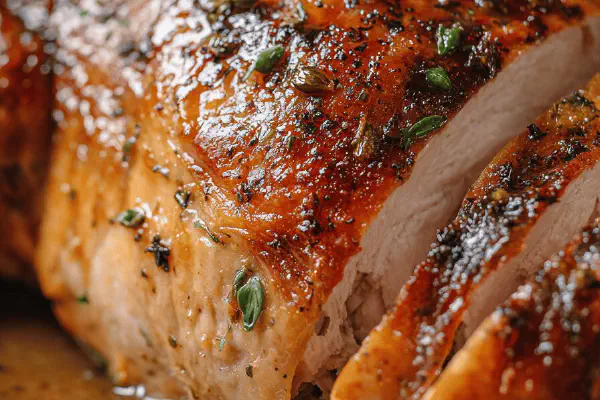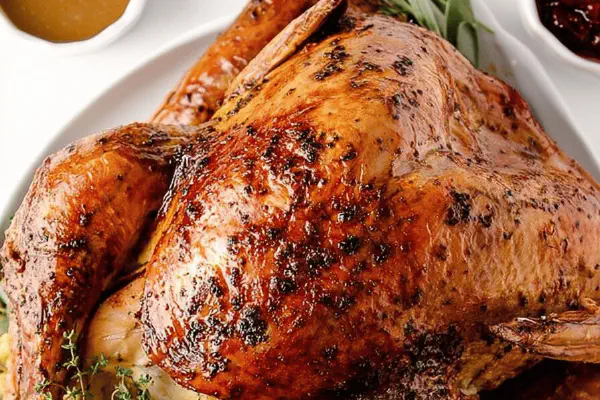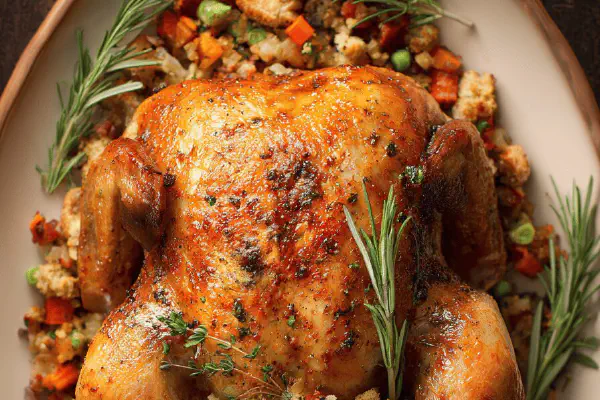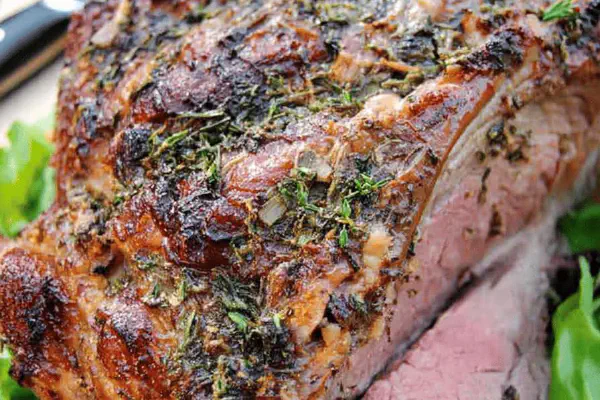Juniper Roasted Turkey

By Emma
Certified Culinary Professional
Ingredients
Turkey
- 1 turkey about 5 kg halved or quartered – halves better if you have a big oven
- 18 ml salt (3 1/2 teaspoons)
- 12 ml crushed juniper berries (1 tablespoon)
- 5 ml crushed coriander seeds (1 teaspoon)
- 2 ml black pepper freshly ground (about 1/2 teaspoon)
- 60 ml aquavit or dry white gin (1/4 cup) – aquavit adds herbal depth
- 50 g cold butter diced (about 3 1/2 tablespoons)
Pearl Onion Sauce
- 20 red pearl onions peeled (reduce a bit)
- 3 garlic cloves minced finely
- 30 ml butter (2 tablespoons)
- 20 ml rye flour (1 1/2 tablespoons) – swap wheat flour for a nuttier note
- 1 litre beef stock (4 cups)
- 20 ml aquavit or dry white gin (1 1/2 tablespoons)
- Salt and pepper freshly ground
About the ingredients
Method
Turkey Prep and Brine
- Scatter the turkey pieces into a deep ceramic or glass dish. Combine salt, crushed juniper, coriander seeds, and pepper thoroughly. Rub this all over every nook of the bird pieces. Then drizzle aquavit evenly, covering the meat with a plastic wrap. Refrigerate for about 10 to 14 hours. Overnight if you can. This dry brine is crucial—pulls moisture, seasons deep, juniper oils penetrate. Discard any liquid; no rinsing needed. Pat dry with paper towels. Be sure turkey is dry — skin won’t crisp otherwise.
Roasting Setup
- Place your oven rack smack in the middle. Preheat to 210 °C (410 °F) for that initial blast. Line a rimmed baking sheet with parchment paper. Butter cubes ready to go. Lay turkey on the tray skin side up. Dot and spread butter pieces on the skin generously. Butter melts, fat drips, flavor seeps under the skin — key for moist breast meat and golden crackly skin. Patience to let butter layer under skin is well spent.
Roast
- Slide into hot oven 55 minutes. Listen carefully: skin hisses and crackles lightly, bubbling butter visible around edges. After 55 min, reduce heat to 180 °C (355 °F). Roast an additional 35 to 40 minutes, depending on bird size and oven quirks. Use a meat thermometer — inserted deep into thickest breast — look for 73 °C (163 °F). Remove when done. Let rest loosely tented with foil for 12 minutes minimum. Resting distributes juices evenly, skin firms to shatter crispness.
Sauce with Pearl Onions
- While turkey roasts, work on sauce. Melt butter in large sauté pan over medium heat. Toss peeled pearl onions and garlic in, cooking gently until onions soften and edges get translucent (about 8 to 10 minutes). Don’t rush, patient stirring ensures tender pearls without browning. Sprinkle rye flour evenly over onions, stir briskly so flour coats and cooks out raw taste—1 to 2 minutes. Gradually whisk in beef stock and aquavit, scraping any brown bits stuck to pan rim. Bring to a simmer. It’ll thicken gradually — watch consistency. Keep stirring every few minutes for 18 to 22 minutes until sauce lightly coats a spoon. Season with salt and pepper last — always adjust at end; stock saltiness varies.
Carving and Serving
- Carve turkey finely across the grain. Juices should run clear, texture firm but yielding. If overcooked, dry carcass discourages any sauce magic; too rare, texture rubbery. Pour sauce into warm gravy boat or spoon generously onto plates. Serve alongside sliced turkey. The slightly sweet onion pearls burst mild acidity counterbalanced by herbaceous bite from aquavit and juniper. Remember, flavor develops with time and rest, don’t rush slicing.
Tips and Tricks
- If no aquavit, substitute with dry white gin or vodka with touch of dill or caraway seed infusion—simulate herbal aroma. Rye flour adds rustic nuttiness, but all-purpose flour works just fine. If pearl onions unavailable, chopped shallots sautéed slow can substitute but lose pearl texture. Avoid foil wrapping turkey skin during roasting—it steams skin, killing crispness. Always baste sparingly; butter dripping suffices if skin dry enough. Rest turkey uncovered briefly before tenting for better skin retention. Use a probe thermometer if oven is uneven—leave probe in during cooking.
- Avoid overcrowding baking sheet for even roast. If skin browns prematurely, tent loosely with foil mid-cook; resume roasting without foil near end for crisp finish. Watching, smelling, listening crucial—you’ll know when skin bubbles and crackles. Substitute beef stock with homemade chicken stock if necessary, but beef adds depth. Sauce thickens slowly—don’t rush by increasing heat; risks lumps. Keep stirring consistently.
- This method evolved after many messy roasting attempts when skin stayed wet or meat dry. The dry brine with juniper and coriander, plus aquavit trick, gives subtle piney depth, aligns well with rye flour’s offbeat texture in sauce. Pearl onions impart sweetness with a bite. A dish with character, not fuss, that’s what I aim for.
Cooking tips
Chef's notes
- 💡 Dry brine key step. Salt pulls moisture, breaks fibers slightly. Juniper crushed gently or bitterness creeps. Aquavit adds herbal lift, use gin if none. Butter under skin—not melted; cold solid pieces. Push gently between skin and meat. Skin crackles sound tells when nearly done. Pat dry turkey well—wet skin steams, no crisp. Line baking tray with parchment; avoids sticking, easier clean.
- 💡 Slow sweat pearl onions and garlic over medium heat. No rush. Onions soften, edges translucent, not brown. Stir often but carefully. Rye flour stirred in coats onions evenly, cook 1-2 minutes to kill raw taste. Add stock slowly, whisk constantly—hitting lumps means too fast. Simmer gently until thick enough to coat spoon—overheat ruins texture. Season at end. Stock saltiness varies wildly—adjust sparingly.
- 💡 Initial oven blast 210 °C (410 °F) sets skin browning and crisp. After 55 minutes, drop heat to 180 °C (355 °F) for even cooking. Meat thermometer essential. Insert deep in breast; target 73 °C (163 °F). Pull earlier means rubbery, later dry. Rest 12 minutes loosely tented foil to redistribute juices. Don’t wrap tightly or skin steams soft. Skin changes from glossy wet to matte gold—watch closely.
- 💡 Butter melting under skin bastes breast internally, keeps moist. Spread thick chunks evenly but carefully. Don’t tear skin. If oven uneven, use probe thermometer with wire, leave in. Skin crackles with faint hissing, bubbling butter visible edges. If skin browns too fast, loosely tent foil mid-roast then remove last 10 minutes for crisp finish. Avoid overcrowding pan; air circulation critical.
- 💡 Substitutions: no aquavit—gin or vodka infused with dill/caraway works. Rye flour can be all-purpose if needed, but sauce less character. Pearl onions rare? Slow sauté shallots as fallback but lose pearl texture and sweetness. Beef stock adds depth but chicken stock tolerable. Garlic must not brown or turns bitter; adjust heat carefully. Patience key in sauce—rush thickening leads to lumps or burnt flavor.
Common questions
How to know when turkey is done?
Thermometer best—73 °C deep breast. Skin crackle sound, hissing butter spots. Golden matte skin—not wet or pale. If too early, meat rubbery; too late, dry and stringy. Timing varies by bird size and oven quirks.
Can I skip dry brining?
Skip—expect less juicy meat, fewer flavors penetrating. Skin won’t dry, will steam when roasting. If short on time, brine minimum 6 hours mostly cold salt only. No rinsing after brine; pat dry always.
Sauce too thick or thin?
Too thick add stock little by little, warm only. Too thin simmer longer but low heat; sudden boil lumps flour. Stir constantly. Use rye or all-purpose flour, rye gives nuttier, all-purpose smoother. Patience over heat.
How store leftovers?
Cool quickly, fridge in sealed container 3-4 days max. Sauce can separate; reheat gently, whisk. Freeze turkey sliced or whole parts wrapped airtight, 2-3 months. Defrost slowly in fridge. Reheat with sauce for moistness.



